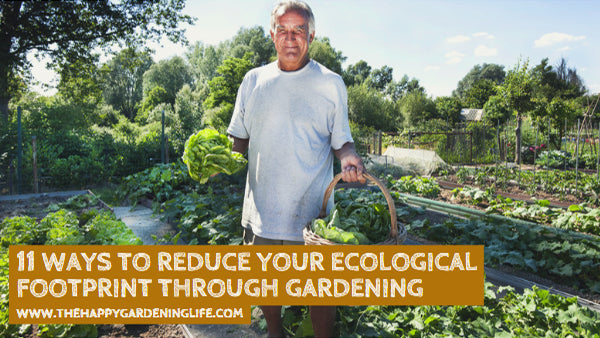
11 Ways to Reduce Your Ecological Footprint Through Gardening
Share
 A home garden may be small, but it can have a powerful impact when it comes to reducing environmental waste and pollution. The more people use sustainable gardening solutions, the more we’re able help the Earth and lessen the effects of climate change.
A home garden may be small, but it can have a powerful impact when it comes to reducing environmental waste and pollution. The more people use sustainable gardening solutions, the more we’re able help the Earth and lessen the effects of climate change.
Sustainable gardening’s main goal is to grow a garden that’s both edible and eco-friendly. This is where organic gardening comes into play.
This type of gardening is simply one of the most efficient and environmetally-friendly methods out there—which is why more and more growers are starting their own organic gardens at home.
Organic gardening only makes use of natural growing methods such as using compost, mulching, companion planting, and the like. No pesticides and other chemicals are involved, that’s why it’s so much better for the environment.
So if you want to do your bit for our planet in your own little way, be sure to start an organic garden and apply these sustainable gardening practices below. This way, you can reduce your environmental footprint and help make the world a better place.
Like this blog post? Share it on your favorite social networks today!
Reducing Your Environmental Footprint in the Garden
1. Plant trees.
Planting trees helps to store carbon from the atmosphere into the soil. Trees can also cool your home in summer and let in the winter sun. If you don’t have room for trees at your place, volunteer with a local landcare group.
2. Grow your own organic food.
Not only does this help to reduce the distance your food travels before it hits your plate, but it also helps to save water and fossil fuels.
3. Compost your waste.
The less green garden waste and food scraps going into landfill the better, and you get to use the compost in your sustainable garden.
4. Take responsibility for your gardening practices.
Think very carefully before you reach for the bug spray or synthetic fertilizer! So many good, sustainable alternatives exist — use your compost to help feed your plants, and get worms and insects working for you.
5. Help stop the spread of environmental weeds.
Find out what plants have become weeds in your area and, if you have them or they pop up, either get rid of them safely or contain them.
6. Minimize your use of powered tools.
Mowers, blowers and brush-cutters can make life easier, but think about their environmental impact. Buy an energy-efficient mower, mow less often and keep the grass height to about 4 to 5 centimeters — it’s better for your sustainable lawn as well.
7. Start a list of groups of like-minded people you can join or learn from.
Local knowledge goes a long way in establishing sustainable practices.
8. Get the kids into sustainable gardening.
At home, at school or in the community, if kids learn the right way from the beginning, they’re sure to keep gardening sustainably into the future.
9. Only use renewable resources in the garden.
Check the source of gardening materials, and make sure you reuse, recycle and renew. Think about where your pavers, sleepers and mulch come from and how they’re manufactured.
10. Create a haven with a diverse range of plants.
Not only do you help increase plant biodiversity, but you also provide a habitat for animals, beneficial insects and birds.
11. Build your garden for the future, not for fashion.
Make your garden climate-friendly and water-wise. Understand your environment, weather patterns and the plants that thrive where you live, not what the magazines dictate.
Article Source: Sustainable Gardening for Dummies Cheat Sheet
